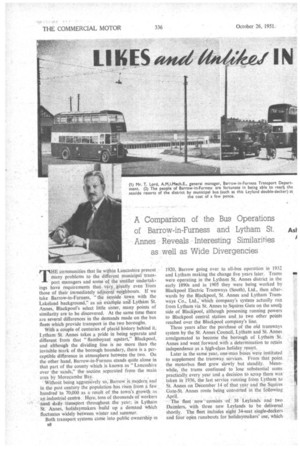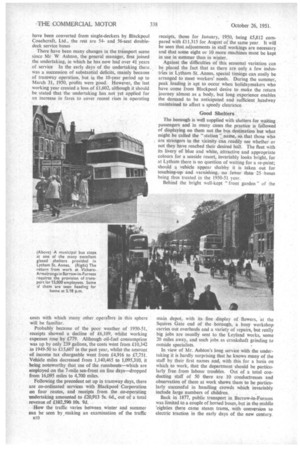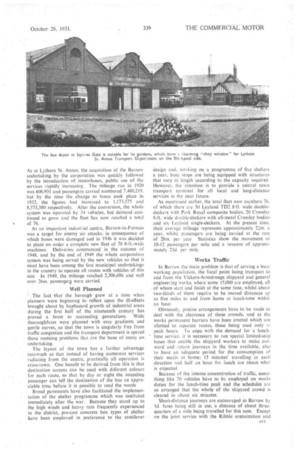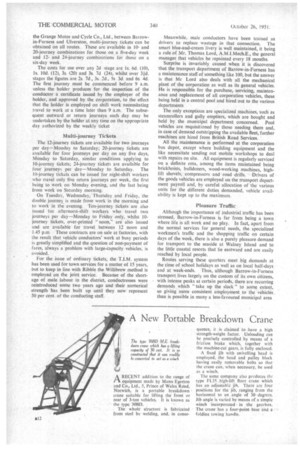LIKESmatiniiiw IN
Page 42

Page 44

Page 45

Page 46

If you've noticed an error in this article please click here to report it so we can fix it.
A Comparison of the Bus Operations
of Barrow-in-Furness and Lytham St. Asi Armes Reveals Interesting Similarities as well as Wide Divergencies THE communities that lie within Landashire present • many problems to the different municipal transport managers and some of the smaller undertakings have requirements that vary , greatly even from those of their immediately adjacent neighbours. If we take Barrow-in-Furness, "the seaside town with the Lakeland background," as an exaMple an Lytham St. Annes, Blackpool's select little sister, many points of similarity are to be discovered. At the same time there are several differences in the demands made on the bus fleets which provide transport in the two boroughs.
With a couple of centuries of placid history behind it, Lytham St. Annes takes a pride in being separate and different from that "flamboyant upstart,' Blackpool, and although the dividing line is no more than the invisible mark of the borough boundary, there is a perceptible difference in atmosphere between the two. On the other hand, Barrow-in-Furness stands quite alone in that part of the county which is known as "Lancashire over the sands," the section separated from the main
area by Morecambe Bay. . , Without being aggressively so, Barrow is modern and in the past •century the population has risen from a few . hundred to 70000 as a• result of the town's growth,as . an industrial centre Here; tens of thousands of workers need daily •transport throughout the year in Lytham St. Armes, holidaymakers build up a demand which fluctuates Widely between winter and summer.
Both transport systems came into public ownership in e8
1920, Barrow going over to all-bus operation in 1932 and Lytham making the change five years later. Trams were operating in the Lytham St. Annes district in the early 1890s and in 1905 they were being worked by Blackpool Electric Tramways (South), Ltd., then afterwards by the BlackpooL.St. Annes and Lytham Tramways Co., Ltd., which company's system actually ran from Lytham via St. Annes to Squires Gate on the south side of Blackpool, although possessirig running powers to Blackpool central station and to two other points reached over the Blackpool company's line.
Three years after the purchase of the old tramways system by the St. Annes Council, Lytham and St. Annes amalgamated to become the borough of Lytham St. Annes and went.forward_with a determination to retain independence as a high-class holiday resort.
Later in the same year, one-man buses' were instituted to supplement the tramway services. From that point the motorbus fleet grew slowly but steadily. Meanwhile, the trams continued to lose substantial sums practically, every year and a decision to scrap them was' taken in 1936, the last service running from Lytham to St. Armes on December 14 of that year and the Squires Gate St Annes route being converted in the following April.
-The fleet now "consists of 38 Leylands and two Daimlers, with three new Leylands to be delivered shortly. The fleet includes eight 34-seat single-deckers and four open runabouts for holidaymakers' use, which
have been converted from single-deckers by Blackpool Coachcraft, Ltd., the rest are 54and 56-seat doubledeck service buses There have been many changes in the transport scene since Mr W Ashton, the general manager, first joined the undertaking, in which he has now had over 41 years of service In the early days of the undertaking there was a succession of substantial deficits, mainly because of tramway operation, but in the 10-year period up to March 31, 1950, profits were good. However, the last working year created a loss of £1,602, although it should be stated that the undertaking has not yet applied for an increase in fares to cover recent rises in operating costs with which many other operators in this sphere will be familiar.
Probably because of the poor weather of 1950-51, receipts showed a decline of £6,109, whilst working expenses rose by £779. Although oil-fuel consumption was up by only 239 gallons, the costs went from £10,342 in 1949-50 to £15,607 in the past year, whilst the amount of income tax chargeable went from £4,916 to £7,751. Vehicle miles decreased from 1,140,465 to 1,095,310, it being noteworthy that use of the runabouts—which are employed on the 7-mile sea-front on fine days—dropped from 16,095 miles to 4,700 miles.
Following the precedent set up in tramway days, there are co-ordinated services with Blackpool Corporation on four routes, and receipts from the co-operating undertaking amounted to £20,913 5s. 6d., out of a total revenue of £102,590 10s. 9d.
How the traffic varies between winter and summer can be seen by making an examination of the traffic Bit) receipts, those for January, 1950, being £5,812 compared with £11,315 for August of the same year. It will be seen that adjustments in staff workings are necessary and that some eight or 10 more machines must be kept in use in summer than in winter.
Against the difficulties of this seasonal variation can be placed the fact that as there are only a few industries in Lytham St. Annes, special timings can easily be arranged to meet workers' needs. During the summer, peak loading is apt to occur when holidaymakers who have come from Blackpool desire to make the return journey almost as a body, but long experience enables the demand to be anticipated and sufficient .headway maintained to affect a speedy clearance.
Good Shelters
The borough is well supplied with shelters for waiting passengers and in many cases the practice is followed of displaying on them not the bus destination but what might be called the "station " name,.. so that those who are strangers in the vicinity can readily see whether or not they have reached their desired halt. The fleet with its livery of blue and white, attractive and appropriate colours for a seaside resort, invariably looks bright, for at Lytham there is no question of waiting for a re-paint; should a vehicle appear shabby it is taken out for touching-up and varnishing, no fewer than • 25 .buses being thus treated in the 1950-51 year.
Behind the bright well-kept "front garden" of the main depot, with its fine display of flowers, at the Squires Gate end of the borough, a busy workshop carries out overhauls and a variety of repairs, but really big jobs are usually sent to the Leyland works, some 20 miles away, and such jobs as crankshaft grinding to outside specialists.
In view of Mr. Ashton's long service with the undertaking it is hardly surprising that he knows many of the staff by their first names and, with this for a basis on which to work, that the department should be particularly free from labour troubles. Out of a total conducting staff of 50 there are 10 conductresses and observation of them at work shows them to be particularly successful in handling crowds which invariably include large numbers of children, • .
Back in 1877, public transport in Barrow-in-Furness was limited to .a couple of horsed buses, but in the middle 'eighties there came steam trams, with conversion to electric traction in the early days of the new century.
As at Lytham St. Annes, the acquisition of the Barrow undertaking by the corporation was quickly followed by the introduction of motorbuses, public use of the services rapidly increasing. The mileage run in 1920 was 606,931 and-passengers carried numbered 7,480,219, but by the time the change to buses took place in 1932, the figures had increased to 1,173,575 and 8,573,380 respectively. After the conversion,, the whole system was operated by 34 vehicles, but demand continued to grow and the fleet has now reached a total of 76.
As an important industrial centre, Barrow-in-Furness was a target for enemy air attacks, in consequence of which buses were damaged and in 1946 it was decided to place on order a complete new fleet of 70 8-ft-wide machines. Deliveries commenced in the autumn of 1948, and by the end of 1949 the whole corporation system was being served by the new vehicles so that it must have been among the first municipal undertakings in the country to operate all routes with vehicles of this size In 1949, the mileage reached 2,306,686 and well over 26m. passenger were carried.
Well Planned .
The fact that the borough grew at a time when planners were beginning to reflect upon the ill-effects brought about by haphazard growth of industrial areas during the first half of the nineteenth century has proved a boon to succeeding generations. Wide thoroughfares were planned with easy gradients and gentle curves, so that the town is singularly free from traffic congestion and the transport department is spared those routeing problems that are the bane of many an undertaking.
• The layout of the town has a further advantage inasmuch as that instead of having numerous services radiating from the centre, practically all operation is cross-town_ One benefit to be derived from this is that destination screens can be used with different colours for each route, so that by day or night the intending passenger can telt the destination of the bus an appreciable time before it is possible to read the words Broad pavements have also facilitated the implementation of the shelter programme which was instituted immediately after the war. Because they stand up to the high winds and heavy rain frequently experienced in the district, pre-cast concrete box types of shelter have been employed in preference to the cantilever
design and, working on a programme of live 'shelters a year, busy stops are being. equipped with Structures that vary in length according to the capacity required. However, the intentionis to provide -a central town transport terminal for all local and long-distance services in the near future.
As mentioned earlier, the total fleet now numbers 76, of which there are 50 Leyland TD2 8-ft. wide doubledeckers with Park Royal composite bodies, 20 Crossley 8-ft. wide double-deckers with all-metal Crossley bodies and six Leyland single-deckers. At the present time. their average mileage represents approximately 21m. a year, whilst passengers are being carried at the rate of 28m. per year Statistics shOw the movement of 10-12 passengers per mile and a revenue of approximately 231-.1. per mile.
Works Traffic In Barrow the main problem is that of serving a busy working population, the focal point being transport to and from the Vickers-Arrnstrongs shipyard and general engineering works, where some 15,01)0 are employed, all of whom start and finish at the same time, whilst about Iwo-thirds.of them require to be moved distances up to five miles to and from home at lunch-time within an hour.
Obviously, precise arrangements have to be made to deal with the clearance of these crowds, and at the works permanent barriers have been erected which are allotted to separate routes, these being used only at peak hours. To cope with the demand for a lunchtime service, it is necessary to run special limited-stop buses that enable the shipyard workers to make outward and return journeys in the time available, also to have an adequate period for the consumption of their meals at home; 15 minutes' travelling in each direction and half an hour for lunch are about whai. is expected
Because of the intense concentration of traffic, something like 70 vehicles have to be employed on works duties for the lunch-time peak and the schedules are so arranged that the whole of the shipyard crowd is cleared in about six minutes..
Short-distance journeys are encouraged in Barrow by Id. fares being still in use, a distance of about threequarters of a mile being travelled for this sum. Except on the joint service with the Ribble organization' and the Grange Motor and Cycle Co., Ltd., between Barrowin-Furness and Ulverston, multi-journey tickets can be obtained on all routes. These are available in 10and 20-journey combinations for those on a five-day week and 12and 24-journey combinations for those on a six-day Week.
The costs for use over any 2d stage are Is. 6d. (10), Is. 10d. (12), 3s. (20) and 3s. 7d (24), whilst over 3W. stages the figures are 2s. 7d , 3s. 2d., 5s 3d. and 6s 44. The first journey must be commenced before 9 a.m. unless the holder produces for the inspection of the condrietor a certificate issued by the employer of the holder, and approved by the corporation, to the effect that the holder is employed on shift work necessitating travel to work at a time later than 9 a.m. The subsequent outward or return journeys each day may be undertaken by the holder at any time on the appropriate day authorized by the weekly ticket • Multi-journey Tickets The 12-journey tickets are available for two journeys per day—Monday to Saturday; 20-journey tickets are available for four journeys per day on any live days, Monday to Saturday, similar conditions applying to 10-journey tickets; 24-journey tickets are available for four journeys per day—Monday to Saturday. The 10-journey tickets can be issued for night-shift workers who travel only five return journeys per week, the first being to work on Monday evening, and the last being from work on Saturday morning.
On Tuesday, Wednesday, Thursday and Friday, the double journey, is made from work in the morning and to work in the evening. Ten-journey tickets are also issued for afternoon-shift workers who travel two journeys per day—Monday to Friday only, whilst 10journey tickets, over-printed " noon," are also issued and are available for travel between 12 noon and 1.45 p.m. These contracts are on sale at factories, with the result that vehicle conductors' work at busy periods is greatly simplified and the question of non-payment of fares, always a problem with large-capacity vehicles, is avoided.
For the issue of ordinary tickets, the T.I.M. system has been used for town services for a matter of 15 years, but to keep in line with Ribble the Willibrew method is employed on the joint service. Because of the shortage of male labour in the district, conductresses were reintroduced some two years ago and their numerical strength has been built up until they now represent 50 per cent, of the conducting staff.
Meanwhile, male conductors have been trained as drivers to replace wastage in that connection. The smart blue-and-cream livery is well maintained, it being a rule of Mr. Thomas Lord, A.M.I.Mech.E., the general manager that vehicles be repainted every 18 months.
Surprise is invariably caused when it is discovered that the transport department of Barrow-in-Furness has a maintenance staff of something like 100, but the answer is that Mr Lord also deals with all the mechanical plant of the corporation as well as its general vehicles. He is responsible for the purchase, servicing, maintenance and replacement of all corporation vehicles, these being held in a central pool and hired out to the various departments The only exceptions are specialized machines, such as steamrollers and gully emptiers, which are bought and held by the municipal department concerned. Pool vehicles are requisitioned by those needing them and, in case of demand outstripping the available fleet, further machines are hired from British Road Services.
All the maintenance is performed at the corporation bus depot, except where building equipment and the like necessitate sending out mobile workshops to deal with repairs on site. All equipment is regularly serviced on a definite rota, among the items maintained being brickhoists, bulldozers, wood-working machines, highlift shovels, compressors and road drills. Drivers of the goods vehicles are employed on the transport department payroll and, by careful allocation of the various units for the different duties demanded, vehicle availability is kept tip to the maximum.
Pleasure Traffic
Although the importance of industrial traffic has been stressed, Barrow-in-Furness is far from being a town where life is all work and no play. In fact, apart front the normal services for general needs, the specialized workmen's traffic and the shopping traffic on certain days of the week, there is also a purely pleasure demand for transport to the seaside at Walney Island and to the little coastal resorts that lie eastward and are easily reached by local people.
Routes serving these quarters meet big demands at the time of school holidays as well as on local half-days and at week-ends. Thus, although Barrow-in-Furness transport lives largely on the custom of its own citizens, with intense peaks at certain periods, there are recurring demands which "take up the slack" to some extent, so giving more consistent employment to the vehicles than is possible in many a less-favoured municipal area




















































































